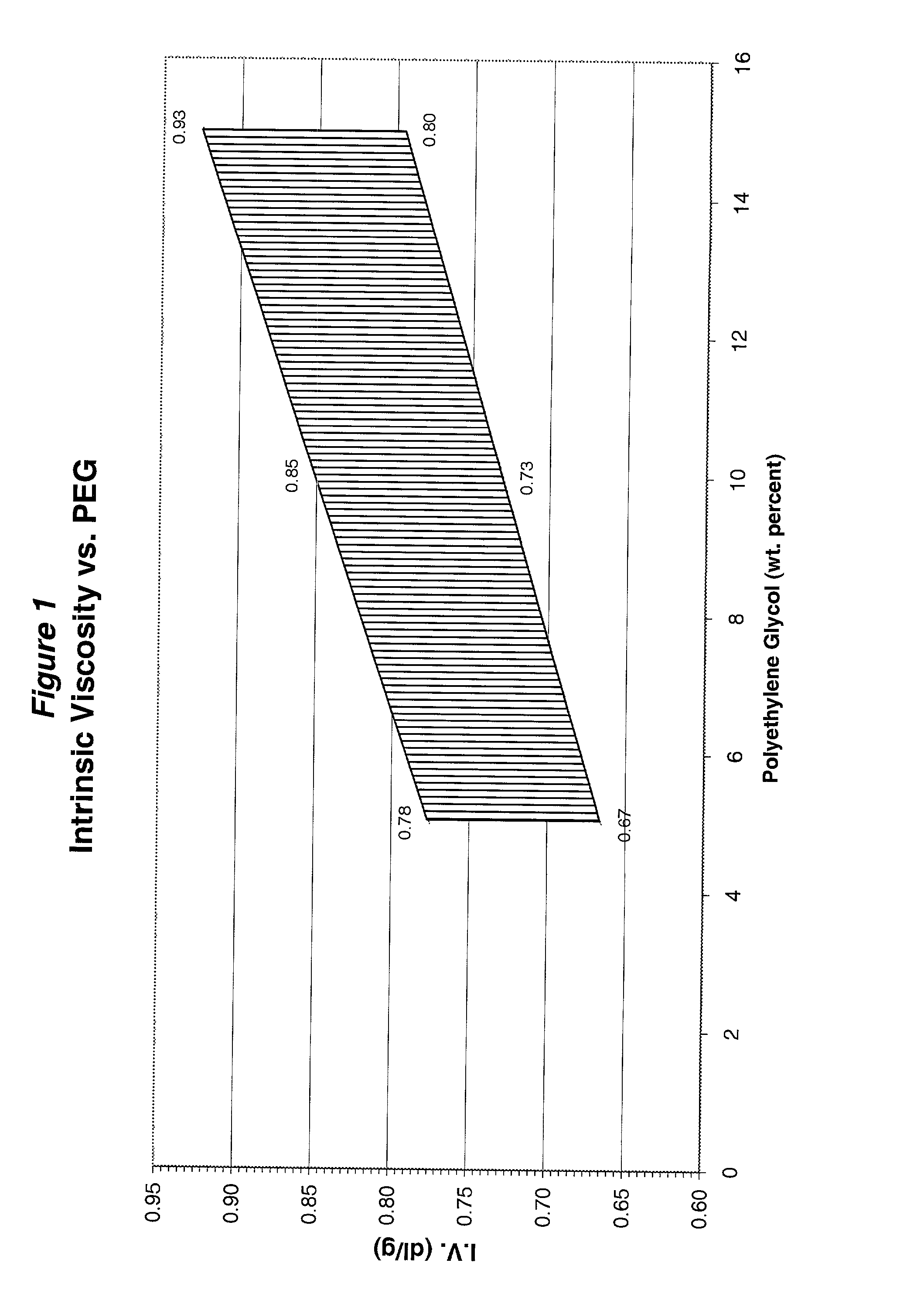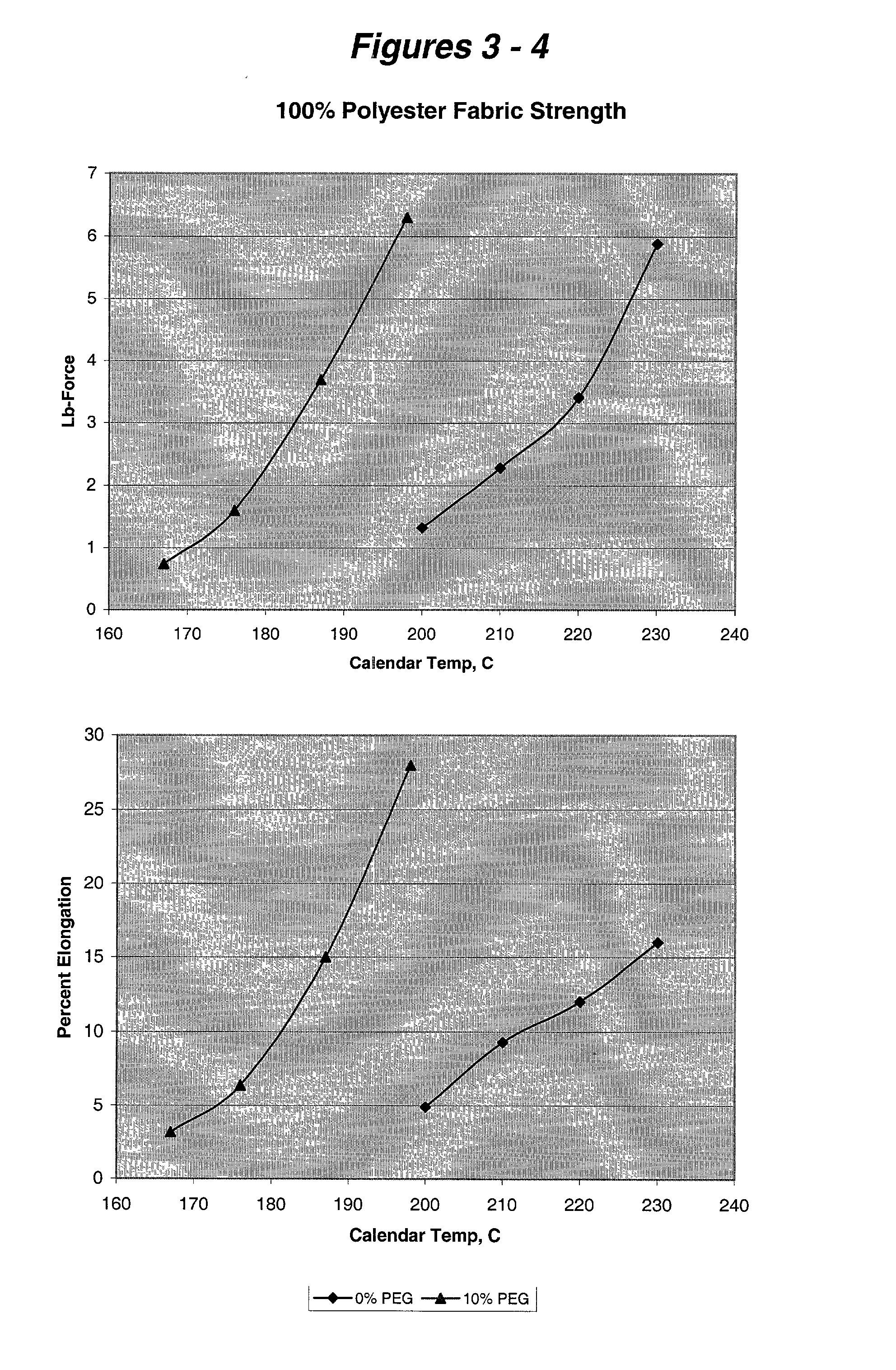Polyethylene glycol modified polyester fibers
a technology of polyethylene glycol and modified polyester, which is applied in the direction of natural mineral layered products, dyeing process, weaving, etc., can solve the problems of unfavorable garment use of polyester, so as to promote hydrophobic fibers, and reduce dyeing and energy expenditure
- Summary
- Abstract
- Description
- Claims
- Application Information
AI Technical Summary
Benefits of technology
Problems solved by technology
Method used
Image
Examples
example 1
[0128] The copolyester fabric used in the testing was a 2.times.2 twill fabric using a 150 denier 100 filament count textured continuous filament yarn formed from copolyester fibers including between about 10 and 12 weight percent polyethylene glycol having a molecular weight of about 400 g / mol. A comparison fabric made of conventional polyester was also employed. This fabric was plain woven, 38.times.58 greige count with crimped polyethylene terephthalate filament yarn, and a fabric weight of 4.3 oz / sq.yd.
[0129] The copolyester fabric was washed according to AATCC Test Method 124-1996, on normal cycle, at 105.degree. F. for eight minutes, to remove spin finishes and size materials. A pot dyeing method was used, wherein the liquor ratio was 10:1 and the fabric size was about 5".times.12". Dyeing temperature was raised from ambient to 212.degree. F. at a rate of 3.degree. F. / minute and held at 212.degree. F. for 30 minutes with a dye concentration of 3 percent on weight of fabric (ow...
example 2
[0173] Melt Polymerization
[0174] The copolyester composition was polymerized like standard polyethylene terephthalate, except that the polymerization temperature was 10.degree. C. lower than normal. Polyethylene glycol, having an average molecular weight of 400 g / mole, was injected into the process before the initiation of the polymerization at a rate sufficient to yield 10 weight percent polyethylene glycol in the copolyester composition. Likewise, pentaerythritol was added before polymerization at a rate that would yield 500 ppm in the copolyester composition. The copolyester was then extruded, quenched, and cut. The quench water was 10.degree. C. colder than normal. The copolyester was crystallized 10.degree. C. lower than normal. The copolyester was melt polymerized to an intrinsic viscosity of 0.62 dl / g.
[0175] Solid State Polymerization
[0176] The copolyester chip was solid state polymerized like a normal polyethylene terephthalate bottle resin chip except that the chip was main...
example 3
[0187] Melt Polymerization
[0188] The copolyester composition was polymerized like standard polyethylene terephthalate, except that the polymerization temperature was 10.degree. C. lower than normal. Polyethylene glycol, having an average molecular weight of 400 g / mole, was injected into the process before the initiation of the polymerization at a rate sufficient to yield 10 weight percent polyethylene glycol in the copolyester composition. Likewise, pentaerythritol was added before polymerization at a rate that would yield about 400 ppm in the copolyester composition. The copolyester was then extruded, quenched, and cut. The quench water was 10.degree. C. colder than normal. The copolyester was crystallized 10.degree. C. lower than normal. The copolyester was melt polymerized to an intrinsic viscosity of 0.78 dl / g.
[0189] Filament Spinning
[0190] The copolyester formed POY like a conventional polyethylene terephthalate product having the same filament count, except that the spinning t...
PUM
| Property | Measurement | Unit |
|---|---|---|
| Fraction | aaaaa | aaaaa |
| Fraction | aaaaa | aaaaa |
| Fraction | aaaaa | aaaaa |
Abstract
Description
Claims
Application Information
 Login to View More
Login to View More - R&D
- Intellectual Property
- Life Sciences
- Materials
- Tech Scout
- Unparalleled Data Quality
- Higher Quality Content
- 60% Fewer Hallucinations
Browse by: Latest US Patents, China's latest patents, Technical Efficacy Thesaurus, Application Domain, Technology Topic, Popular Technical Reports.
© 2025 PatSnap. All rights reserved.Legal|Privacy policy|Modern Slavery Act Transparency Statement|Sitemap|About US| Contact US: help@patsnap.com



